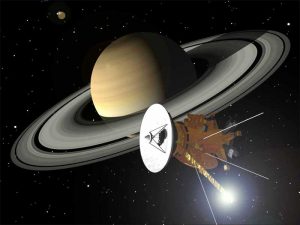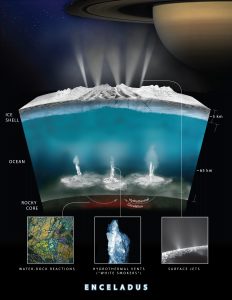Two days ago NASA held a press conference to announce some of the results that scientists have discovered from the Cassini spacecraft. Cassini is in orbit around the planet Saturn and is in the final few months of it’s twenty year long mission.

The press conference mainly dealt with some new discoveries about Saturn’s moon Enceladus which we knew from earlier observations was an ice covered world similar to Jupiter’s moon Europa. For several years now NASA astronomers have speculated that, again like Europa, Enceladus might have a liquid ocean beneath the ice covering, an ocean that could support life.
Now the heat energy that keeps the ocean warm would come from the flexing and squeezing of the moon’s interior caused by the interacting gravitational fields of Saturn and it’s other moon’s, the tidal pulls. The same process is known to cause the numerous volcanoes on Jupiter’s moon Io and are suspected to keep the ocean on Europa warm. The heat generated by this process could also provide the energy for life on Enceladus.
Images taken of Enceladus by Cassini have discovered plumes of water spewing out of the Moon like geysers and now Cassini has even succeeded in flying through those plumes and identifying some of the chemicals contained in them. In their announcement NASA scientists stated that Cassini has detected considerable amounts of both Carbon Dioxide and Methane both of which are commonly associated with living processes. The image below details the processes going on at the moon.

These results give us another possible home for life in our Solar system. Along with Mars and Europa, Enceladus is another world we need to explore further. A specialized mission to search for life on Enceladus may take years to develop and launch however, but someday we’ll know whether or not we have close neighbors living around the ringed planet.
If you’d like to read more about NASA’s announcement click on the link below.
There has also been another announcement from NASA concerning grant money being funded to a series of new technology programs. These grants are called the NASA Innovative Advanced Concept or NIAC program and are intended to study possible future technologies for spaceflight. The initial Phase I grants are about $125,000 dollars while Phase II grants can be as much as a half a million dollars.
The Phase I grants can be very interesting, even far out concepts while the Phase II grants tend to be a bit more realistic. In the Phase I group are included four completely new type of propulsion technologies, two are intended for interstellar travel, along with a ‘vacuum balloon’ to drift over the surface of Mars and Solar Surfing!
The Phase II grants include a probe of the interior of the planet Venus and a fusion enabled Pluto orbiter and lander. If you’d like to read a bit more about these possible future space technologies click on the link below.
https://www.nasa.gov/directorates/spacetech/niac/2017_Phase_I_Phase_II
There’s always something new happening in space so I hope you’ll be coming back soon.
